There is impressive science behind the theory of goal setting. This post is a sampling of the research on goal setting, in chronological order.
This goal setting research list contains most of the high points on our understanding of the importance of goal setting found by scientists, psychologists and other researchers over the past 40+ years. Enjoy.
To learn more about achieving great things and the importance of goals check out goal setting theory.
Improving Job Performance Through Training in Goal Setting
20 tree logging operators were randomly assigned to either a 1-day training program in goal setting or a control group. The additional wood cut over the following 3 months by those in the goal-setting group was estimated to be worth a quarter of a million dollars. Absenteeism fell and production increased.
A Review of Research on The Application of Goal Setting in Organizations
“Twenty-seven studies on goal setting were reviewed to evaluate the practical feasibility of goal setting in organizations and to evaluate Locke's theories of goal setting. The organizational research reviewed provides strong support for Locke's proposition that specific goals increase performance and those difficult goals, if accepted, result in better performance than do easy goals.”
Joint Effect of Feedback and Goal Setting on Performance: A Field Study of Residential Energy Conservation
In this study, the effect of goal difficulty and frequent feedback for encouraging energy conservation was assessed.
80 families were placed into one of four groups:
| Difficult Goal | Easy Goal | |
|---|---|---|
| Frequent Feedback | Frequent Feedback + Difficult Goal | Frequent Feedback + Easy Goal |
| No Feedback | No Feedback + Difficult Goal | No Feedback + Easy Goal |
Those in the difficult goal group were asked to cut their energy consumption by 20%, while those in the easy group were asked to cut their consumption by 2%. Those in the frequent feedback group were told three times a week how much their consumption had declined.
The only group whose consumption fell a significant amount was the frequent feedback + difficult goal group. For the duration of the study, their consumption fell an average of 14%.
Abstract here.
Interrelationships Among Employee Participation, Individual Differences, Goal Difficulty, Goal Acceptance, Goal Instrumentality, and Performance
Over a ten-week period, weekly productivity goals were either assigned by the manager or set jointly with the employee.
As all 41 subjects were typists, the performance was easy to measure (e.g. it's easy to measure the number of pages typed, the frequency of errors, and so on). The primary purpose of the study was to show that goals that are jointly set will generate more motivation than those which are ‘forced'. This hypothesis was proven wrong. Later studies would show that goal acceptance requires understanding the reasons why a goal was set, not being a part of the goal-setting process.
Other findings from this study:
- Those who had difficult goals performed higher.
- Those with a high need for achievement and an internal locus of control set more difficult goals.
- Goal setting was more effective for those employees with high self-esteem, and for those who felt working harder would be rewarded.
Abstract here.
Goal Setting and Task Performance
“Results from a review of laboratory and field studies on the effects of goal setting on the performance show that in 90% of the studies, specific and challenging goals led to higher performance than easy goals, “do your best” goals or no goals. Goals affect performance by directing attention, mobilizing effort, increasing persistence, and motivating strategy development. Goal setting is most likely to improve task performance when the goals are specific and sufficiently challenging, Ss have sufficient ability (and ability differences are controlled), feedback is provided to show progress in relation to the goal, rewards such as money are given for goal attainment, the experimenter or manager is supportive, and assigned goals are accepted by the individual. No reliable individual differences have emerged in goal-setting studies, probably because the goals were typically assigned rather than self-set. Need for achievement and self-esteem may be the most promising individual difference variables.”
Goal Difficulty vs. Performance
“A previous review of the goal-setting literature found strong evidence for a linear relationship between goal difficulty and task performance (assuming sufficient ability), and more recent studies have supported the earlier findings. Four results in three experimental field studies found harder goals led to better performance than easy goals:”
- Increasing Productivity With Decreasing Time Limits: A Field Replication of Parkinson's Law, 1975 (tree logging).
- Interrelationships Among Employee Participation, Individual Differences, Goal Difficulty, Goal Acceptance, Goal Instrumentality, and Performance, 1978 (typists).
- A Study of The Effects of Task Goal and Schedule Choice on Work Performance, 1979.
“Twenty-five experimental laboratory studies have obtained similar results with a wide variety of tasks:”
- Knowledge of Score and Goal Level as Determinants of Work Rate, 1969 (addition).
- Studies of The Relationship Between Satisfaction, Goal Setting, and Performance, 1970 (reaction time and addition).
- The Effects of Participation in Goal Setting on Goal Acceptance and Performance, 1975 (coding task).
- A Two-Factor Model of The Effect of Goal-Descriptive Directions on Learning From Text, 1975 (prose learning).
- Additive Effects of Task Difficulty and Goal Setting on Subsequent Task Performance 1976 (chess).
- Role of Performance Goals in Prose Learning, 1976 (prose learning).
- The Motivational Strategies Used by Supervisors: Relationships to Effectiveness Indicators, 1976 (card sorting).
- Effects Achievement Standards, Tangible Rewards, and Self-Dispensed Achievement Evaluations on Children's Task Mastery, 1977 (color discrimination).
- Systems Analysis of Dyadic Interaction: Prediction From Individual Parameters, 1978 (figure selection task).
- The Interaction of Ability and Motivation in Performance: An Exploration of The Meaning of Moderators, 1978 (perceptual speed).
- Effects of Goal Level on Performance: A Trade-off of Quantity and Quality, 1978 (brainstorming, figure selection and sum estimation tasks).
- Importance of Supportive Relationships in Goal Setting, 1979 (brainstorming).
- The Effects of Holding Goal Difficulty Constant on Assigned and Participatively Set Goals, 1979.
- The Effect of Beliefs on Maximum Weight-Lifting Performance, 1979.
- Another Look at The Relationship of Expectancy and Goal Difficulty to Task Performance, 1980 (perceptual speed).
Goal Specificity vs. Performance
“Previous research found that specific, challenging (difficult) goals led to higher output than vague goals such as “do your best”. Subsequent research has strongly supported these results… Twenty four field experiments all found that individuals are given specific, challenging goals either outperformed those trying to “do their best”, or surpassed their own previous performance when they were not trying for specific goals:”
- Improving Job Performance Through Training in Goal Setting, 1974 (tree logging).
- Changes in Performance in a Management by Objectives Program, 1974 (marketing and production workers).
- Assigned Versus Participative Goal Setting With Educated and Uneducated Woods Workers, 1975 (tree logging).
- The “Practical Significance” of Locke's Theory of Goal Setting, 1975 (truck loading).
- Effects of Goal Setting on Performance and Job Satisfaction, 1976 (sales personnel).
- Effects of Assigned and Participative Goal Setting on Performance and Job Satisfaction, 1976 (typists).
- Effect of Performance Feedback and Goal Setting on Productivity and Satisfaction in an Organizational Setting, 1976 (customer service).
- The Role of Proximal Intentions in Self-Regulation of Refractory Behavior, 1977 (dieting).
- Performance Standards and Implicit Goal Setting: Field Testing Locke's Assumption, 1977 (keypunching).
- Blue Collar to Top Executive, 1977 (ship loading).
- Different Goal Setting Treatments and Their Effects on Performance and Job Satisfaction, 1977 (maintenance technicians).
- Importance of Participative Goal Setting and Anticipated Rewards on Goal Difficulty and Job Performance, 1978 (engineering and scientific work).
- The Effects of Assigned Versus Participatively Set Goals, and Individual Differences When Goal Difficulty is Held Constant, 1979 (clerical test).
- and performance appraisal activities, coding, managerial training, card sorting, die casting, customer service, and pastry work (see the study for citations).
“Twenty laboratory studies supported the above results either partially or totally (see the study for list).”
Feedback vs. No Feedback
“Integrating the two sets of studies points to one unequivocal conclusion: neither [feedback] alone nor goals alone is sufficient to affect performance. Both are necessary. Together they appear sufficient to improve task performance.”
Why Does Goal Setting Often Lead to Improved Performance?
“1. Direction. Most fundamentally goals direct attention and action. 2. Effort. Since different goals may require different amounts of effort, an effort is mobilized in proportion to the perceived requirements of the goal or task. Thus, more effort is mobilized to work on hard tasks (which are accepted) than easy tasks. Sales (1970) found that higher workloads produce the higher subjective effort, faster heart rates, and higher output per unit time than lower workloads. 3. Persistence. Persistence is nothing more than directed effort extended over time; thus it is a combination of the previous two mechanisms. 4. Strategy Development. While the above three mechanisms are relatively direct in their effects, this last mechanism is indirect. It involves developing strategies or action plans for attaining one's goals.”
Participatory vs. Forced
“Participation has long been recommended by social scientists as a means of getting subordinates or workers committed to organizational goals and/or of reducing resistance to change. However, an extensive review of the participation in decision-making literature by Locke and Schweiger (1979), found no consistent difference in the effectiveness of top-down (“autocratic”) decision making and decisions made with subordinate participation:”
- Goal Characteristics and Personality Factors In a Management By-Objectives Program, 1970.
- Effects of Goal Setting on Performance and Job Satisfaction, 1976.
- Different Goal Setting Treatments and Their Effects on Performance and Job Satisfaction, 1977.
- Assigned Versus Participative Goal Setting With Educated and Uneducated Woods Workers, 1975.
- Effects of Assigned and Participative Goal Setting on Performance and Job Satisfaction, 1976.
- Importance of Participative Goal Setting and Anticipated Rewards on Goal Difficulty and Job Performance, 1978.
- The Effects of Holding Goal Difficulty Constant on Assigned and Participatively Set Goals, 1979.
- The Effects of Assigned Versus Participatively Set Goals, KR, and Individual Differences When Goal Difficulty is Held Constant, 1979.
- The Effects of Participation in Goal Setting on Goal Acceptance and Performance, 1975.
- Importance of Supportive Relationships in Goal Setting, 1979
“There appear to be two possible mechanisms by which participation could affect task motivation. First, participation can lead to the setting of higher goals that would be the case without participation. Second, participation could, in some cases, lead to greater goal acceptance than assigned goals.”
“Likert has pointed out that when assigned goal setting is effective as in the above studies, it may be because the supervisors who assign the goals behave in a supportive manner. It may be that being supportive is more crucial than participation in achieving goal acceptance. Participation itself, of course, may entail being supportive.”
“Further, it is possible that the motivational effects of participation are not as important in gaining performance improvement as are its cognitive effects. Locke found that the single most successful field experiment on participation to date stressed the cognitive benefits; participation was used to get good ideas from workers as to how to improve performance efficiency.” -Participative Decision-Making: An Experimental Study in a Hospital, 1973.
Full study here.
The Importance of Union Acceptance for Productivity Improvement Through Goal Setting
“Interviews were conducted with union business agents on conditions necessary for their support of a goal-setting program. Subsequent to the interviews, goals were assigned to 39 truck drivers. The results were analyzed using a design that included a comparison group (N= 35). The results showed a significant increase in productivity for the drivers who received specific goals. When the conditions necessary for the union's support of the goal-setting program were no longer met, there was a wildcat strike.” –Abstract
The study was estimated to have saved the company $2.7 million dollars through increased productivity.
The Effect of Goal-Setting and Daily Electronic Feedback on In-Home Energy Use
300 households were assigned to one of six groups, with 4 of those groups being given a goal to reduce household energy consumption by 10% during the following year. Of those four groups, one received daily feedback (IND), another monthly feedback (MEF), another was instructed to monitor their energy consumption by themselves (SMO), and another received only information about how to conserve energy, receiving no feedback (INF).
As can be seen in the chart below, over the following year the groups reduced their energy consumption in proportion to how frequently they received feedback, with the daily feedback group going above and beyond the 10% goal and reducing consumption by 12% for some time.
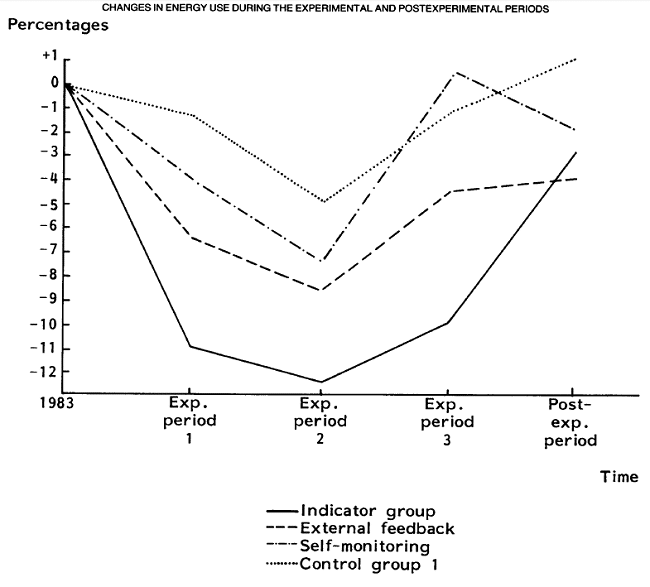
Full study here.
Improving Safety Performance With Goal Setting and Feedback
Three departments that were lagging behind in their compliance with safety guidelines were selected for this year-long study. During the 3 month baseline period, average safety compliance (e.g. wearing leather gloves while welding; clearing away tripping hazards, etc…) was around 55%. Compliance was estimated using four observers, who made a total of 167 observations throughout the entire study. After the baseline period, employees were given an hour-long safety training session. Compliance increased by about 10%.
After another three months, employees were told to set the challenging goal of increasing compliance to 90%. During the following 4 months, compliance once again increased by about 10%. Finally, a large graph was hung in a prominent location in each department, containing the department's average safety compliance (similar to the graph below). Compliance immediately shot up above the goal target, showing that a goal is much more likely to be successfully pursued when frequent feedback is provided (the graph was updated three times a week).
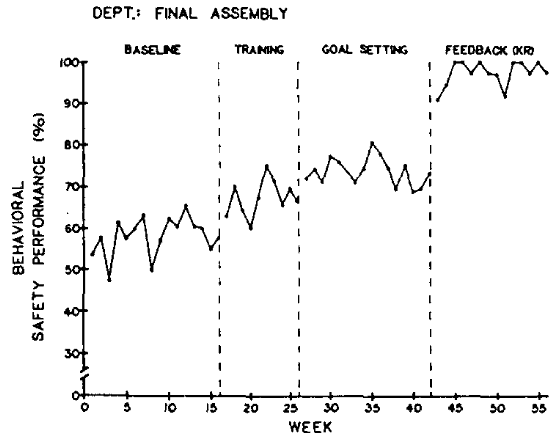
“People tend to subconsciously set their own goals when they receive performance feedback.”
Abstract here.
Goal Setting Research: 1997
Integrating “Classic” and “Contemporary” Approaches to Achievement Motivation: A Hierarchical Model of Approach and Avoidance Achievement Motivation.
This study introduces the trichotomous model of achievement motivation, combining the mastery/performance model with the approach/avoidance model into the trichotomous mastery, performance-approach, and performance-avoidance model:
“Thus, three independent achievement goals are posited: A mastery goal focused on the development of competence or the attainment of task mastery, a performance-approach goal focused on the attainment of competence relative to others, and a performance-avoidance goal focused on the avoidance of incompetence relative to others. Master and performance-approach goals are construed as approach orientations… whereas performance-avoidance goal is construed as an avoidance orientation.”
“Performance goals were presumed to lead to the “helpless” response pattern upon failure because failure directly implies a lack of ability; learning goals, on the other hand, were posited to lead to the “mastery” response pattern, because failure feedback could simply be construed as helpful information in the process of developing competence or mastering a task.”
“Individuals high in need for achievement are drawn to achievement activities because they anticipate the pride that they will experience if successful, whereas those high in fear of failure find achievement activities averse because they anticipate the shame that they will experience if unsuccessful.”

This model was later expanded by others into a 2×2 framework (performance-approach, performance-avoidance; mastery-approach, mastery-avoidance).
Full study here.
Goal Setting Research: 2000
The Effects of Goal Setting and Self-Instruction Training on The Performance of Unionized Employees
“This study assesses the effectiveness of goal setting, goal setting plus training in self-instruction, and being urged to do one's best on the performance of unionized employees (n = 32). Appraisals were made prior to and 10 weeks following three interventions. ANCOVA indicated that employees who set specific, difficult goals had significantly higher performance than those in doing one's best and those doing goal setting plus self-instruction.” –Abstract
However, despite the claims of the abstract, while the results are statistically significant, the effect size is small enough to call into question the effectiveness of the intervention (e.g. the numbers all look pretty much the same):
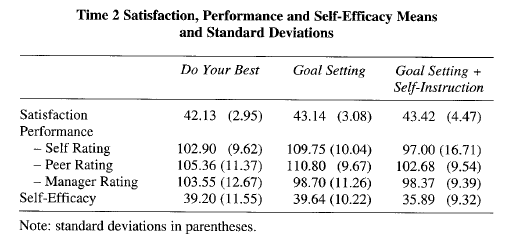
Full study here.
Goal Setting Research: 2001
A 2 x 2 Achievement Goal Framework.
Until 2001, when this study was published, goals were divided into three types: mastery, performance-approach, and performance-avoidance
| Mastery | Performance-Approach | Performance-Avoidance |
|---|---|---|
| I will score higher than last time. | I will score the highest in my class. | I will avoid scoring worse than my classmates. |
| I will exercise three times a week. | I will look sexy by losing 5 pounds. | I will stop looking ugly by losing 5 pounds. |
| I will learn how to get my work done better and faster. | I will get a good performance review. | I will avoid getting negative feedback. |
A mastery goal was one where a person tried to accomplish something in absolute or intrapersonal terms, e.g. setting a new personal best or learning a new skill. A performance-approach goal was one where a person tried to do better than their peers, e.g. scoring higher or getting promoted. A performance-avoidance goal was one where a person tried to avoid doing worse than their peers, e.g. avoid embarrassment or negative feedback.
Until this study, it was assumed that mastery goals were the best, performance-approach goals were sometimes good and sometimes bad, and performance-avoidance goals were always bad. The implicit assumption was there were no bad mastery goals (in other words, no mastery-avoidance goals.)
This study challenged that assumption by first proving that master-avoidance goals exist, and second proving that each goal type can be useful, depending on the circumstances.
Study details here. Full study here.
Goal Setting Research: 2002
Building a Practically Useful Theory of Goal Setting and Task Motivation
This is another of Locke's goal-setting literature reviews.
“We found a positive, linear function in that the highest or most difficult goals produced the highest levels of effort and performance. Performance leveled off or decreased only when the limits of ability were reached or when commitment to a highly difficult goal lapsed.”
“We found that specific, difficult goals consistently led to higher performance than urging people to do their best. In short, when people are asked to do their best, they do not do so. This is because do-your-best goals have no external referent and thus are defined idiosyncratically. This allows for a wide range of acceptable performance levels, which is not the case when a goal level is specified.”
“Other factors being equal, expectancy is said to be linearly and positively related to performance. However, because difficult goals are harder to attain than easy goals, the expectancy of goal success would presumably be negatively related to performance. The apparent contradiction between the two theories is resolved by distinguishing expectancy within versus expectancy between goal conditions. Locke, Motowidlo, and Bobko (1986) found that when goal level is held constant, which is implicitly assumed by valence–instrumentality–expectancy theory, higher expectancies lead to higher levels of performance. Across goal levels, lower expectancies, associated with higher goal levels, are associated with higher performance.”
“Goals affect performance through four mechanisms. First, goals serve a directive function; they direct attention and effort toward goal-relevant activities and away from goal irrelevant activities…Second, goals have an energizing function. High goals lead to greater effort than low goals. This has been shown with tasks that (a) directly entail physical effort, (b) entail the repeated performance of simple cognitive tasks, such as addition; (c)include measurements of subjective effort, and (d) include physiological indicators of effort. Third, goals affect persistence. When participants are allowed to control the time they spend on a task, hard goals prolong effort. Fourth, goals affect action indirectly by leading to the arousal, discovery, and/or use of task-relevant knowledge and strategies.”
“An assigned goal is as effective as one that is set participatively provided that the purpose or rationale for the goal is given. However, if the goal is assigned tersely (e.g., “Do this . . . ”) without explanation, it leads to performance that is significantly lower than for a participative set goal… the primary benefit of participation in decision making is cognitive rather than motivational in that it stimulates information exchange. For example, Latham et al. (1994) found that with goal difficulty level controlled, participation in goal setting had no beneficial effect on performance. However, people who participated with others in formulating task strategies performed significantly better and had higher self-efficacy than those who did not participate in formulating strategies.”
“When the goal is very difficult, paying people only if they reach the goal (i.e., a task-and-bonus system) can hurt performance. Once people see that they are not getting the reward, their personal goal and their self-efficacy drop and, consequently, so do their performance. This drop does not occur if the goal is moderately difficult or if people are given a difficult goal and are paid for performance (e.g., piece rate) rather than goal attainment.”
“Self-efficacy enhances goal commitment. Leaders can raise the self-efficacy of their subordinates (a) by ensuring adequate training to increase mastery that provides success experiences, (b) by role modeling or finding models with whom the person can identify, and (c) through persuasive communication that expresses confidence that the person can attain the goal.”
“For goals to be effective, people need summary feedback that reveals progress in relation to their goals. If they do not know how they are doing, it is difficult or impossible for them to adjust the level or direction of their effort or to adjust their performance strategies to match what the goal requires. If the goal is to cut down 30 trees in a day, people have no way to tell if they are on target unless they know how many trees have been cut. When people find they are below target, they normally increase their effort or try a new strategy.”
“As the complexity of the task increases and higher-level skills and strategies have yet to become automatized, goal effects are dependent on the ability to discover appropriate task strategies.”
“Goals are, at the same time, an object or outcome to aim for and a standard for judging satisfaction… People with high goals produce more because they are dissatisfied with less. The bar for their satisfaction is set at a high level. This is why they are motivated to do more than those with easy goals… The highest degree of anticipated satisfaction averaged across all grade outcomes, was for students with a goal of C, and the lowest was for students with a goal of earning an A.”
“Numerous studies have shown that setting a specific difficult goal leads to significant increases in employee productivity.”
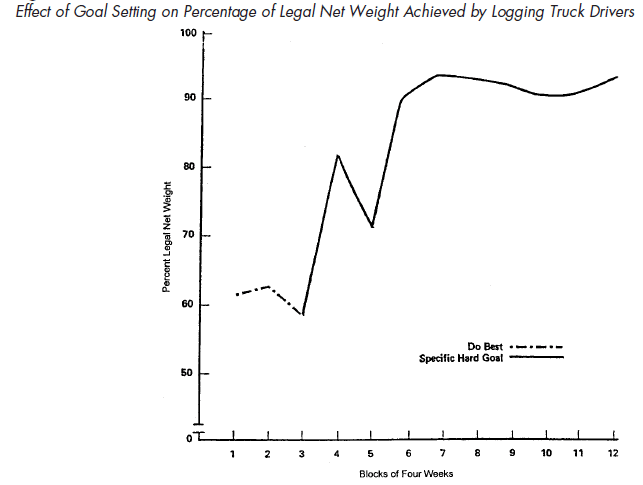
“We noted earlier that on tasks that are complex for people, learning goals can be superior to performance goals. However, there have been almost no studies examining the use of both together. Intriguing findings have been obtained by Harackiewicz, Barron, Carter, Lehto, and Elliott (1997) with college students. Performance goals improved grades but did not affect interest, whereas learning goals enhanced interest in the class but did not affect grades.”
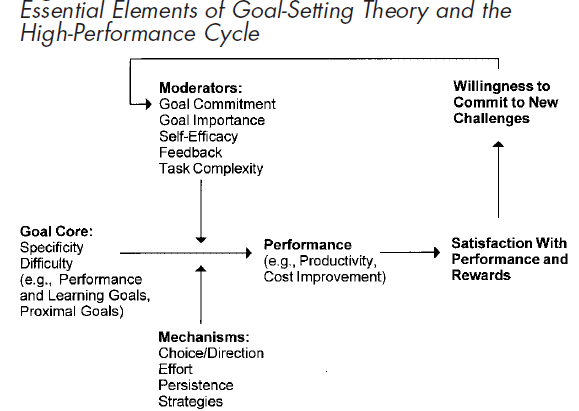
Goal Setting Research: 2005
Avoidance Goals Can Be Beneficial: A Look at Smoking Cessation
In this study, the authors examined the use of avoidance goals for helping 591 smokers quit. Avoidance goals have already been repeatedly shown to do worse than approach goals. The reason the authors tried again was that they split avoidance goals into two types: prevention and cure.
“As with traditional conceptualizations of avoidance goals, some avoidance goals involve preventing a negative state from occurring (e.g., I do not want to get cancer). However, other avoidance goals involve curing a negative state that already exists (e.g., I want to get rid of chronic cough).”
The reason why cure-avoidance goals might be more effective than prevent-avoidance goals:
“Researchers have argued that trying to stay away from a state elicits anxiety, which in turn undermines how much effort people will put forth to work on the goal. Moreover, even if progress is made on a prevent goal, the difficulty of detecting the continued absence of something may make the progress hard to recognize. For example, people trying to prevent developing cancer may find it difficult to detect a reduction in the risk of developing cancer and thus have a hard time determining whether they have made any progress on their goal.
In contrast, to prevent goals, it may be easier to detect progress when working to meet a cure goal.”
In this study, the smokers were asked why they wanted to quit. From what they wrote, their goals were coded:
“Goals were coded as an approach when the goal described something the participants wanted to get as a result of quitting (e.g., I want to get healthy). Goals were coded as prevent when the goal described something that was not currently true that they wanted to avoid (e.g., I do not want to develop lung cancer). Goals were coded as a cure when the goal described something that was currently true that the participant wanted to get rid of (e.g., I want to stop others from nagging).”
Those with a higher percentage of cure-avoidance goals were more likely to have quit:
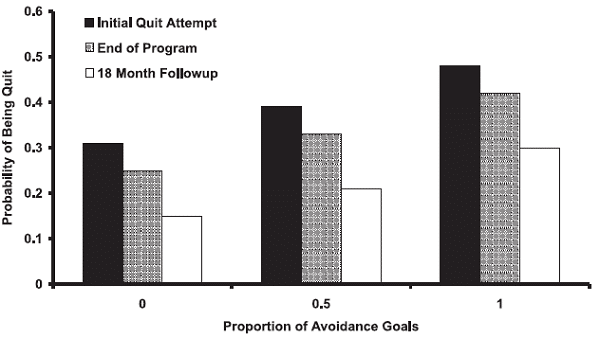
Abstract here.
Goal Setting Research: 2006
The Hierarchical Model of Approach-Avoidance Motivation
This is a high-level review paper. See Integrating “Classic” and “Contemporary” Approaches to Achievement Motivation, 1997, for an introduction to the hierarchical model.
“Approach motivation may be defined as the energization of behavior by, or the direction of behavior toward, positive stimuli (objects, events, possibilities), whereas avoidance motivation may be defined as the energization of behavior by, or the direction of behavior away from, negative stimuli (objects, events, possibilities). Five aspects of this definition are considered further in the following.”
“A core premise of the hierarchical model is that the approach-avoidance distinction is fundamental and basic to motivation, so much so that it may be used as a conceptual lens through which to view the structure and function of self-regulation.”
“Goals are posited to serve a directional function in motivation. That is, goals focus on a specific, cognitively represented endpoint, and serve to guide the individual’s behavior toward or away from that endpoint. Goals are conscious, intentional commitments, although once in place in the cognitive system, they may be activated and may operate in automatic, non-conscious fashion”
“In the hierarchical model, goals are not sufficient to account for motivated behavior, it is also necessary to consider the motivation underlying goals. This motivation comes from many different sources and many be represented in many different ways.”
Full study here.
Integrating Theories of Motivation
In this paper, the authors highlight their new theory of motivation – temporal motivation theory. This theory combines several other motivation theories into one. In particular:
- Expectancy Theory, which states that the more likely a goal is to be accomplished and the larger the potential reward, the greater the motivation (e.g. if a student thinks he is stupid, he might not put in any effort to study, thinking the endeavor to be pointless).
- Hyperbolic Discounting, which states that the further away a reward is into the future, the less it is worth now (e.g. receiving $150 ten years from now would be worth much less to most people than receiving $150 in the next five minutes).
- Impulsivity, which states that for people who are more impulsive, future rewards are worth a lot less than for those who are less impulsive (e.g. impulsive kids have trouble studying because the future is worth less to them).
More on temporal motivation theory here.
Full study here.
Goal Setting Science: 2007
Improving Motivation and Goal Setting for Return to Work in a Population on Sick Leave: A Controlled Study
“The objective of this study was to examine the effect of an intervention focused on motivation, goal setting, and planning of return to work. A total of 2,795 people, across 6 municipalities, on sick leave for at least 21 days received a questionnaire; 1,256 with a self-assessed poor prognosis for fast return to work were eligible for the study. An examination by a specialist in social medicine, followed by additional counseling by a social worker, was offered to 510 residents in two municipalities and accepted by 264 (52%). The goal was to enhance motivation, goal setting, and planning of return to work. The duration of the sick leave and the chance of being gainfully employed were analyzed. The intervention neither shortened sick leave periods nor increased the likelihood of gainful employment after one year. A low-cost counseling program addressing motivation, goal setting, and planning of return to work did not improve vocational outcomes or reduce the duration of sick leave.” –Abstract
The actual goal-setting intervention used was not discussed in the study, making it difficult to learn useful information (e.g. certain kinds of goal setting could be more or less useful for helping people get employment).
Goal Setting Science: 2008
Self-Efficacy and Resource Allocation: Support For a Nonmonotonic, Discontinuous Model
The relationship between goal difficulty and motivation is complex. There are four different theories that attempt to describe that relationship. What is problematic is that there is evidence for each of the theories. This study provides a brief review of the conflicting literature, as well as providing its own support for one of the theories.
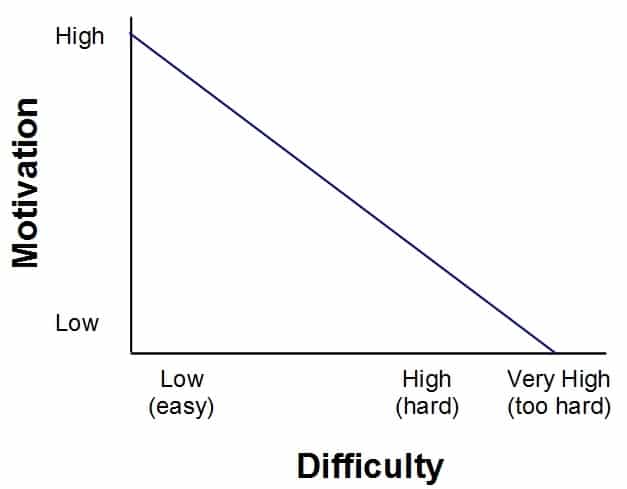
The positive model is the most widely believed, perhaps in part because it is also the most intuitive. The easier a task, the more likely it can be accomplished. There is no point in expending energy (motivation) if it will just be wasted. Conversely, if the goal is certain to be achieved, it makes sense to expend energy trying to accomplish it – the energy won't be wasted, as the reward will definitely be acquired.
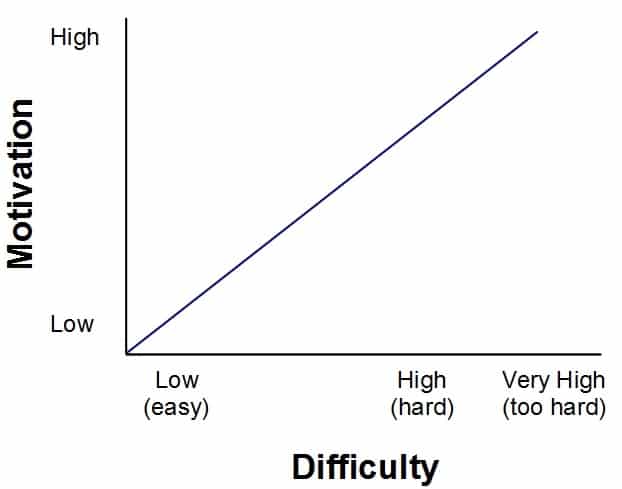
The negative model stands in direct contradiction of the positive model. The idea is that in order for a more difficult goal to be accomplished, more energy must be expended (e.g. in improving one's skills). On the other hand, if success is all but guaranteed, it would be a waste to allocate more than the minimum (e.g. there's no point getting excited and motivated about the goal of eating breakfast – that's a waste of mental energy and glucose; if you want to eat breakfast, it will probably happen, excitement or not).
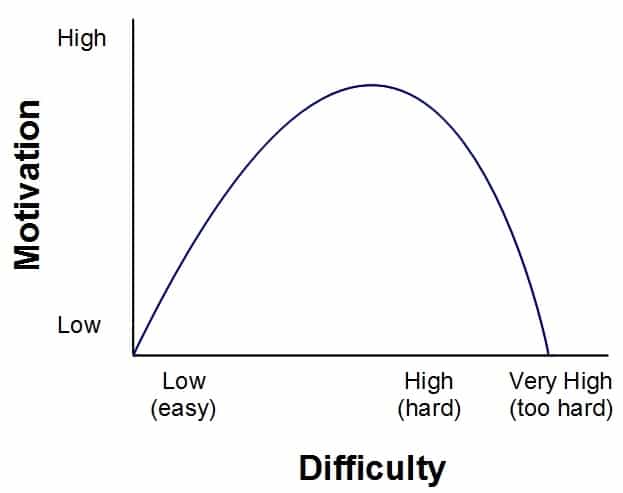
According to the inverted U model, motivation is a function of expectations of success multiplied by the value of the incentive, which in turn is the inverse of expectations of success. Although this model would seem to be a compromise of the positive and negative models, it would be more accurate to consider it an extension of the positive model. This is because it makes one of the same assumptions as the positive model, which is that low expectations of success are de-motivating and that high expectations of success are motivating. The reason this model is an extension is because of the second assumption that it makes – if a goal is easy to accomplish, it must offer a small reward; conversely, if a goal is hard to accomplish, it must offer a large reward.
The inverse U comes from the multiplication of goal difficulty with implied reward size:
Low difficulty is good, but implies low reward, and thus low motivation (.9 * (1-.9) = .09).High difficult is bad, but implies high reward, and thus low motivation (.1 * (1-.01) = .09).Medium difficulty is OK, but implies medium reward, and thus high motivation (.5 * (1 – .5) = .25).
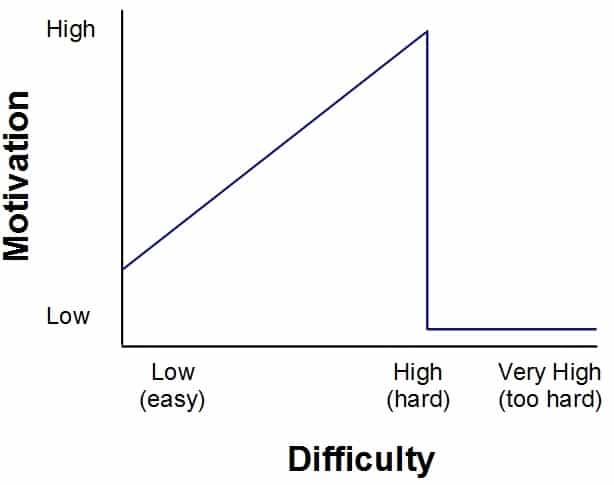
The discontinuous model should be considered an extension of the negative model. Motivation is low for easy goals because the brain is frugal – there is no point getting excited and wasting energy on something simple and easy, like eating breakfast, taking a shower, sending an e-mail, etc… As goal difficulty increases, motivation rises in step – for example, getting a training certification requires more energy than taking a shower, which the brain provides by increasing motivation. Note, an implicit assumption this model makes is that more difficult goals are also more rewarding. For self-set goals, this is a reasonable assumption (e.g. memorizing the entire dictionary is hard but not motivating… of course, what reasonable person would set a goal like that?)
This model is an extension in that after a certain level of difficulty, motivation immediately drops to near zero. The assumption is that past a certain point, people will feel the task is too challenging – that even with a high level of motivation, their resources or abilities are not enough.
I personally believe the discontinuous model is the most accurate, in part because it best fits with my life experience, and in part, because it is supported by Piers Steel, the motivation scientist I respect the most. Ironically, the positive model better fits Piers's own theory of motivation, so I'm not sure why he supports the discontinuous model in his book, The Procrastination Equation, instead.
According to Edwin Locke, “The apparent contradiction between the two theories is resolved by distinguishing expectancy within versus expectancy between goal conditions. Locke, Motowidlo, and Bobko (1986) found that when goal level is held constant, which is implicitly assumed by valence–instrumentality–expectancy theory, higher expectancies lead to higher levels of performance. Across goal levels, lower expectancies, associated with higher goal levels, are associated with higher performance.”
Said differently, the contradiction can be reconciled by treating goal difficulty and goal expectancy as separate constructs – to maximize motivation, you want high expectancy, but also high perceived difficulty. How to have high expectancy and also the high difficulty is another matter, as usually, the two constructs have an inverse relationship (e.g. becoming a billionaire is a high difficulty but very low expectancy).
Full study here.
Goal Setting Science: 2009
The Relationship of Procrastination With a Mastery Goal Versus an Avoidance Goal
Goals can be classified into many different dimensions. One of the most popular models is the 2×2, approach vs. avoidance vs. mastery vs. performance model:
| Approach | Avoidance | |
|---|---|---|
| Mastery | Mastery-Approach | Mastery-Avoidance |
| Performance | Performance-Approach | Performance-Avoidance |
To better understand what each of these dimensions mean, you can read this page on goal setting or this study which first proposed this model. Although past research agreed that mastery goals are negatively correlated with procrastination (that is, those who make mastery goals are less likely to procrastinate), while avoidance goals are positively correlated with procrastination (that is, those who make avoidance goals are more likely to procrastinate), there has been no consensus on which dimension is more important – mastery/performance or avoidance/approach.
As can be seen in the table below, the avoidance/approach dimension is more important for predicting procrastination than the mastery/performance dimension. Specifically, those with a mastery-approach orientation were the least likely to procrastinate, while those with a mastery-avoidance orientation were the most likely to procrastinate.

Study details here. Abstract here.
Goal Setting Science: 2011
Performance and Learning Goals for Emotion Regulation
In an attempt to feel better after experiencing negative emotions, different people use different strategies. Some talk about their problems with others, other try to distract themselves from thinking those negative thoughts, others try to find something positive from the experience.
There are two strategies that people can use on their own, without help from others: a cognitive reappraisal, and thought suppression/rumination. Cognitive reappraisal is a strategy so effective in dealing with negative emotions that an entire field of psychotherapy has developed around it – cognitive-behavioral therapy. Essentially, it involves re-framing negative events and thoughts into positive ones.
For example, since I was 13 I've experienced a wide variety of health problems. At first, I thought about the problem negatively. However, I gradually started looking for the ‘silver lining'. Because of those health problems, I developed a number of positive health habits, like regular exercise, I developed a degree of persistence and self-confidence I doubt I would have without having had such a large problem to tackle, and I learned how to think critically, having had to deal with dozens of doctors providing false information. Now when I think back to those years of physical pain, I see an experience to be proud of, rather than one to complain and feel bad about.
Thought suppression and rumination are as ineffective as cognitive reappraisal is effective. Rumination involves thinking through, over and over, what went wrong and why. Although one would think that ‘processing' the emotion would cause it to subside, usually the opposite happens, causing the negative emotion to persist. This is because what we focus on grows stronger. Expressing anger, for example, simply makes one angrier. However, that doesn't make suppression effective.
Thought suppression is a strategy of avoidance, e.g. watch TV and eat sugary food in an attempt to redirect attention elsewhere. It seems obvious that there are two strategies for dealing with negative emotion – either express it or suppress it. However, neither work. It's the third option – cognitive reappraisal, that does the job (or think about happy times, get support from friends, etc…).
Those with a performance-avoidance goal towards emotion regulation were most likely to use a rumination/suppression strategy, while those with a mastery goal towards emotion regulation were most likely to use a cognitive reappraisal strategy.
Study details here. Full study here.
Achievement Motives and Emotional Processes in Children During Problem-Solving: Two Experimental Studies of Their Relation to Performance in Different Achievement Goal Conditions
What goal types are most effective for encouraging performance and happiness in children?
In this study, two personality variables and three experimental conditions were investigated. Those with a high motive to achieve success performed better and reported higher satisfaction and happiness than those with a high motive to avoid failure. In addition, those with a high motive to avoid failure reported higher anxiety and worry. As personality variables are difficult to change, while this information is interesting, it is not yet useful.
Of the three experimental conditions, those who were told to write a mastery goal did the best. Compare the mastery instructions with the performance instructions:
| Mastery | Performance |
|---|---|
| ‘‘The problems you have the opportunity to answer today were constructed in a way which will allow you to discover new ways and strategies to solve them if you are working carefully on them. What we are interested in is how much you improve your skills by working with this type of problem. When you have finished, you will have the opportunity to learn whether you did well and made progress toward mastering these tasks.’’ | ‘‘The problems you have the opportunity to answer today were constructed in a way which will allow you to compare your results with others. What we are interested in is how well you perform on the tasks as compared with other sixth-graders. When you have finished, you will have the opportunity to know how well you performed compared with others.’’ |
However, the personality type of participants impacted the effect of goal type (performance vs. mastery). Those high in motive to achieve success performed better in the mastery than in the performance conditions, and those with a high motive to avoid failure did even worse in the performance-avoidance condition.
Study details here. Full study here.
Finally, one proven way to improve your happiness and life satisfaction is to focus on goals that truly matter. To get started, check out this FREE printable worksheet and a step-by-step process that will help you set effective SMART goals.


This is EXTREMELY helpful. Thank you!!!